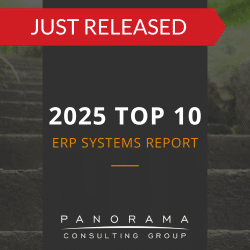You’ve made the investment, applied the resources and done the work. Now it’s time to measure if your ERP project was the success you anticipated.
While there are many ways to gauge the effectiveness of an ERP implementation, the true test lies in the degree of business integration you achieved. In other words, how seamlessly does the new system now fit in your organization?
While this analysis usually takes place at the end of an ERP implementation, you can also assess business integration if your project is still in progress so you can ensure you’re on the right track.
Today, we’re sharing five key signs that can help you determine your level of business integration.
Why Does Business Integration Matter?
At its core, an ERP system is designed to make business processes as quick and easy as possible. This might mean streamlining your quality control processes, simplifying your sales and accounting functions or gaining visibility into your manufacturing and supply chain operations.
However, if your people, processes and technology aren’t aligned and integrated, your ERP software could fail to deliver these benefits.
Aligning Your People, Processes and Technology
How do you align your people, processes and technology? First of all, don’t select technology based on what’s popular or trending at the moment. Instead, select technology based on its ability to support your business goals.
Another piece of advice we give clients is to design future-state business processes that enable these same goals. In some cases, an organization may even need to conduct business process reengineering before ERP selection.
Finally, we recommend equipping employees with the knowledge and skills to effectively use new processes and technology.
The 2024 ERP Report
88.5% of respondents said they deployed or plan to deploy AI at their organization. Learn about AI adoption and other ERP trends by downloading our latest report.
5 Signs of Business Integration
Business integration ensures your organization is positioned to maximize ERP business benefits. Did you prioritize business integration throughout your ERP implementation? Find out by reviewing the signs of business integration:
1. You can Meet Order Delivery Promises
ERP systems are inherently good at helping companies plan their resources across the entire enterprise. This enables companies to deliver goods to their customers in a reliable, dependable and timely manner.
Reliable delivery is essential because today’s buyers are notably more discerning and demanding than previous generations, and delivery promises are held to an increasingly high standard.
One clear sign that your ERP system is integrated into your business processes? You’re not only able to offer earlier delivery timelines, but you can meet them, too. You’ve also achieved visibility into every facet of your supply chain and you’re in constant contact with suppliers.
This is only possible if you select a system based on your business needs and design business processes that support your supply chain management goals.
2. Inventory Levels are Accurate
When your inventory records are accurate, the benefits are obvious. Your order fulfillment capacity increases, your costs lower and your customer satisfaction rates soar.
Companies are often frustrated by an inability to access the timely information they need. However, when an ERP implementation enables full business integration, this data is unlocked, and communication becomes infinitely easier.
As a result, you can better track and report inventory record accuracy (IRA) levels on a routine basis. Moreover, if an IRA failure does occur, you can conduct a root cause analysis to understand what happened. Moving forward, you can implement corrective actions to prevent those failures from happening again.
If you’re experiencing ERP benefits like those mentioned above, you can rest assured that you’ve achieved some level of business integration.

3. Inventory Levels are Balanced
One sign of strong business integration is a balanced inventory that is neither too high nor too low for the level of demand. Essentially, when employees adopt new business processes, organizational silos dissolve and data flows between functional areas. This ensures accurate bills of material and accurate demand forecasts.
4. Reporting is Automated and Simplified
A key part of any digital strategy is transitioning from manual, Excel-based reporting to predictive analytics and AI-enabled reporting.
When you want to measure your level of business integration post-implementation, take a look at your reporting functions. While advanced business intelligence doesn’t depend on business integration alone, it’s a big piece of the puzzle.
5. End-users Have Embraced Change
Employee buy-in is an important component of business integration. As such, it is a key sign that new technology has been absorbed as an integrated function of your business.
Have your employees truly embraced organizational changes? You can measure your change management success using change management metrics.
If this reveals remaining pockets of change resistance, we recommend developing a change management plan in order to strengthen your business integration.
Achieving Business Integration with ERP
An effective ERP implementation methodology recognizes that technology is an enabler of business goals and that ERP projects should not be solely led by the IT department. Only a methodology focused on aligning people, processes and technology leads to strong business integration.
To learn more, request a free consultation below.













